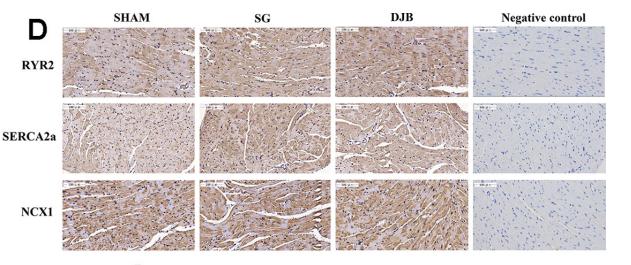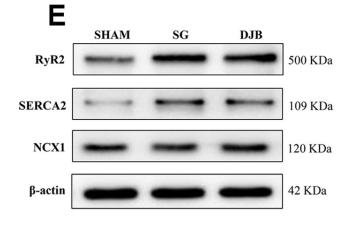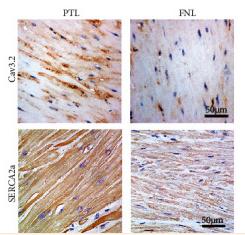产品描述
*The optimal dilutions should be determined by the end user.
*Tips:
WB: 适用于变性蛋白样本的免疫印迹检测. IHC: 适用于组织样本的石蜡(IHC-p)或冰冻(IHC-f)切片样本的免疫组化/荧光检测. IF/ICC: 适用于细胞样本的荧光检测. ELISA(peptide): 适用于抗原肽的ELISA检测.
引用格式: Affinity Biosciences Cat# DF6240, RRID:AB_2838206.
展开/折叠
AT2A2_HUMAN; Atp2a2; ATP2B; ATPase Ca++ transporting cardiac muscle slow twitch 2; Calcium pump 2; Calcium-transporting ATPase sarcoplasmic reticulum type; Calcium-transporting ATPase sarcoplasmic reticulum type slow twitch skeletal muscle isoform; Cardiac Ca2+ ATPase; DAR; DD; Endoplasmic reticulum class 1/2 Ca(2+) ATPase; MGC45367; Sarcoplasmic/endoplasmic reticulum calcium ATPase 2; SERCA 2; SERCA2; serca2a; slow twitch skeletal muscle isoform; SR Ca(2+)-ATPase 2;
抗原和靶标
Isoform 1 is widely expressed in smooth muscle and nonmuscle tissues such as in adult skin epidermis, with highest expression in liver, pancreas and lung, and intermediate expression in brain, kidney and placenta. Also expressed at lower levels in heart and skeletal muscle. Isoforms 2 and 3 are highly expressed in the heart and slow twitch skeletal muscle. Expression of isoform 3 is predominantly restricted to cardiomyocytes and in close proximity to the sarcolemma. Both isoforms are mildly expressed in lung, kidney, liver, pancreas and placenta. Expression of isoform 3 is amplified during monocytic differentiation and also observed in the fetal heart.
- P16615 AT2A2_HUMAN:
- Protein BLAST With
- NCBI/
- ExPASy/
- Uniprot
MENAHTKTVEEVLGHFGVNESTGLSLEQVKKLKERWGSNELPAEEGKTLLELVIEQFEDLLVRILLLAACISFVLAWFEEGEETITAFVEPFVILLILVANAIVGVWQERNAENAIEALKEYEPEMGKVYRQDRKSVQRIKAKDIVPGDIVEIAVGDKVPADIRLTSIKSTTLRVDQSILTGESVSVIKHTDPVPDPRAVNQDKKNMLFSGTNIAAGKAMGVVVATGVNTEIGKIRDEMVATEQERTPLQQKLDEFGEQLSKVISLICIAVWIINIGHFNDPVHGGSWIRGAIYYFKIAVALAVAAIPEGLPAVITTCLALGTRRMAKKNAIVRSLPSVETLGCTSVICSDKTGTLTTNQMSVCRMFILDRVEGDTCSLNEFTITGSTYAPIGEVHKDDKPVNCHQYDGLVELATICALCNDSALDYNEAKGVYEKVGEATETALTCLVEKMNVFDTELKGLSKIERANACNSVIKQLMKKEFTLEFSRDRKSMSVYCTPNKPSRTSMSKMFVKGAPEGVIDRCTHIRVGSTKVPMTSGVKQKIMSVIREWGSGSDTLRCLALATHDNPLRREEMHLEDSANFIKYETNLTFVGCVGMLDPPRIEVASSVKLCRQAGIRVIMITGDNKGTAVAICRRIGIFGQDEDVTSKAFTGREFDELNPSAQRDACLNARCFARVEPSHKSKIVEFLQSFDEITAMTGDGVNDAPALKKAEIGIAMGSGTAVAKTASEMVLADDNFSTIVAAVEEGRAIYNNMKQFIRYLISSNVGEVVCIFLTAALGFPEALIPVQLLWVNLVTDGLPATALGFNPPDLDIMNKPPRNPKEPLISGWLFFRYLAIGCYVGAATVGAAAWWFIAADGGPRVSFYQLSHFLQCKEDNPDFEGVDCAIFESPYPMTMALSVLVTIEMCNALNSLSENQSLLRMPPWENIWLVGSICLSMSLHFLILYVEPLPLIFQITPLNVTQWLMVLKISLPVILMDETLKFVARNYLEPGKECVQPATKSCSFSACTDGISWPFVLLIMPLVIWVYSTDTNFSDMFWS
种属预测
score>80的预测可信度较高,可尝试用于WB检测。*预测模型主要基于免疫原序列比对,结果仅作参考,不作为质保凭据。
High(score>80) Medium(80>score>50) Low(score<50) No confidence
研究背景
This magnesium-dependent enzyme catalyzes the hydrolysis of ATP coupled with the translocation of calcium from the cytosol to the sarcoplasmic reticulum lumen. Isoform 2 is involved in the regulation of the contraction/relaxation cycle. Acts as a regulator of TNFSF11-mediated Ca(2+) signaling pathways via its interaction with TMEM64 which is critical for the TNFSF11-induced CREB1 activation and mitochondrial ROS generation necessary for proper osteoclast generation. Association between TMEM64 and SERCA2 in the ER leads to cytosolic Ca (2+) spiking for activation of NFATC1 and production of mitochondrial ROS, thereby triggering Ca (2+) signaling cascades that promote osteoclast differentiation and activation (By similarity).
Nitrated under oxidative stress. Nitration on the two tyrosine residues inhibits catalytic activity.
Endoplasmic reticulum membrane>Multi-pass membrane protein. Sarcoplasmic reticulum membrane>Multi-pass membrane protein.
Isoform 1 is widely expressed in smooth muscle and nonmuscle tissues such as in adult skin epidermis, with highest expression in liver, pancreas and lung, and intermediate expression in brain, kidney and placenta. Also expressed at lower levels in heart and skeletal muscle. Isoforms 2 and 3 are highly expressed in the heart and slow twitch skeletal muscle. Expression of isoform 3 is predominantly restricted to cardiomyocytes and in close proximity to the sarcolemma. Both isoforms are mildly expressed in lung, kidney, liver, pancreas and placenta. Expression of isoform 3 is amplified during monocytic differentiation and also observed in the fetal heart.
Interacts with sarcolipin (SLN) (By similarity). Interacts with phospholamban (PLN) (By similarity). Interacts with myoregulin (MRLN) (By similarity). Interacts with DWORF (By similarity). Isoform 1 interacts with TRAM2 (via C-terminus). Interacts with HAX1. Interacts with S100A8 and S100A9 (By similarity). Interacts with SLC35G1 and STIM1. Interacts with TMEM203. Interacts with TMEM64 and PDIA3 (By similarity).
Ca(2+) and ATP binding cause major rearrangements of the cytoplasmic and transmembrane domains. According to the E1-E2 model, Ca(2+) binding to the cytosolic domain of the pump in the high-affinity E1 conformation is followed by the ATP-dependent phosphorylation of the active site Asp, giving rise to E1P. A conformational change of the phosphoenzyme gives rise to the low-affinity E2P state that exposes the Ca(2+) ions to the lumenal side and promotes Ca(2+) release. Dephosphorylation of the active site Asp mediates the subsequent return to the E1 conformation.
PLN and SLN both have a single transmembrane helix; both occupy a similar binding site that is situated between the ATP2A2 transmembrane helices.
Belongs to the cation transport ATPase (P-type) (TC 3.A.3) family. Type IIA subfamily.
研究领域
· Environmental Information Processing > Signal transduction > Calcium signaling pathway. (View pathway)
· Environmental Information Processing > Signal transduction > cGMP-PKG signaling pathway. (View pathway)
· Environmental Information Processing > Signal transduction > cAMP signaling pathway. (View pathway)
· Human Diseases > Neurodegenerative diseases > Alzheimer's disease.
· Human Diseases > Cardiovascular diseases > Hypertrophic cardiomyopathy (HCM).
· Human Diseases > Cardiovascular diseases > Arrhythmogenic right ventricular cardiomyopathy (ARVC).
· Human Diseases > Cardiovascular diseases > Dilated cardiomyopathy (DCM).
· Organismal Systems > Circulatory system > Cardiac muscle contraction. (View pathway)
· Organismal Systems > Circulatory system > Adrenergic signaling in cardiomyocytes. (View pathway)
· Organismal Systems > Endocrine system > Thyroid hormone signaling pathway. (View pathway)
· Organismal Systems > Digestive system > Pancreatic secretion.
文献引用
Application: WB Species: Rat Sample:
Application: WB Species: Rat Sample:
Application: IHC Species: rat Sample: myocardial Ca2
Application: WB Species: rat Sample: myocardial Ca2
Application: IHC Species: Human Sample: clinical myometrium tissues
限制条款
产品的规格、报价、验证数据请以官网为准,官网链接:www.affbiotech.com | www.affbiotech.cn(简体中文)| www.affbiotech.jp(日本語)产品的数据信息为Affinity所有,未经授权不得收集Affinity官网数据或资料用于商业用途,对抄袭产品数据的行为我们将保留诉诸法律的权利。
产品相关数据会因产品批次、产品检测情况随时调整,如您已订购该产品,请以订购时随货说明书为准,否则请以官网内容为准,官网内容有改动时恕不另行通知。
Affinity保证所销售产品均经过严格质量检测。如您购买的商品在规定时间内出现问题需要售后时,请您在Affinity官方渠道提交售后申请。产品仅供科学研究使用。不用于诊断和治疗。
产品未经授权不得转售。
Affinity Biosciences将不会对在使用我们的产品时可能发生的专利侵权或其他侵权行为负责。Affinity Biosciences, Affinity Biosciences标志和所有其他商标所有权归Affinity Biosciences LTD.





